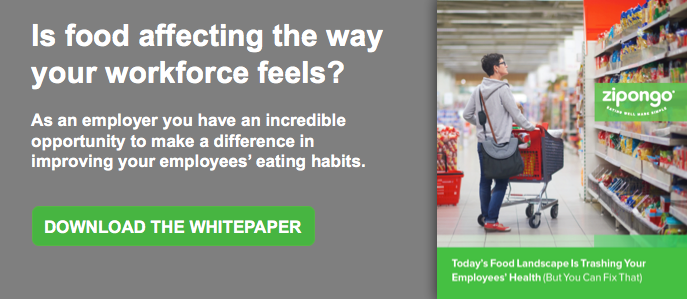Pop quiz: Which of these two foods is healthier?


It’s an insultingly easy question, right? Obviously the fresh fruit is a healthier choice than the French fries.
Now the harder question: Why do people concerned with healthy eating still eat the fries?
If your business is struggling with rising healthcare costs, it’s vital to understand that second question. Eighty-six percent of healthcare expenditures come from people with at least one chronic illness, and the most prevalent chronic illnesses are nutrition-related (like diabetes, obesity, and cardiovascular problems).
Employee wellness programs aim to help employees lead healthier lifestyles, usually by offering rewards for physical activity, tips on healthy eating, weight loss competitions, et al.
Unfortunately, many programs fail to inspire sustainable change, because they fail to address the behavioral science behind our eating habits.
To make a lasting difference, your corporate wellness program has to get at the science of behavior: Why do we still eat the fries? What environmental and behavioral factors compel that choice?
Our digital nutrition platform relies on behavioral science to promote healthier eating. Here’s a sample of what behavioral scientists have to say about dieting, changing habits, and how to make healthy eating a no-brainer.
There’s No Magic Diet – It’s about Behavior
Healthy eating is a cottage industry in the United States. The neverending stream of diet books, eating guides, and supplements all promise fantastic results if we just stick to the program. Eat only green foods. Eat small portions six times a day. Never eat–or eat exclusively– fats/carbs/protein/grains. If you can just find the right diet and have the willpower to follow it, you’ll succeed. If you fail–well, you just didn’t try hard enough.
But decades of research have shown that there’s no one-size-fits-all solution. Dr. Rena A. Wing, a professor of psychiatry and human behavior at Brown University, has run the National Weight Control Registry for 23 years. The registry tracks people who successfully lost weight and maintained the weight loss.
The result: Every person in the registry has their own unique success story. As Wing told Time magazine this year:
“There’s nothing magical about what they do. Some people emphasize exercise more than others, some follow low-carb diets, and some follow low-fat diets. The one commonality is that they had to make changes in their everyday behaviors.” [emphasis mine]
There are a million ways to eat better, and it appears that one is not intrinsically better than the others. It’s about changing your behavior and sticking to it.
How to Change a Behavior
If you’re in charge of your organization’s employee wellness program, all you have to do is change your employees’ behavior. Which, of course, is far easier said than done, but not impossible.
BJ Fogg, PHD, is a behavioral scientist at Stanford University. After over 20 years of studying human behavior, he developed The Fogg Method, a three-step process for designing behavioral change. Here’s how Fogg puts it:
Step 1: Get Specific – What behavior do you want? Translate target outcomes and goals into behaviors. Instead of “reduce snacking on junk food,” a specific goal might be, “cut candy consumption in half.”
Step 2: Make it Easy – How can you make the behavior easy to do? Simplicity changes behavior. For example, if you want employees to eat apples instead of potato chips, make apples the first thing they see in your cafeteria. And, on the flip side, put the potato chips in a drawer at knee level.
Step 3: Trigger the Behavior – What will prompt the behavior? Some triggers are natural. Some you must design. If your goal is, say, to encourage proper portioning of snack foods, swap your big containers of chips or nuts for single-serving bags. Or provide a subtler trigger: put single-serving-size bowls next to the big bag.
To sum up, in order to change a behavior you should have specific, measurable outcomes in mind, remove obstacles to the desired behavior, and design a “trigger” to prompt the desired behavior.
That last bit sounds a little ominous, doesn’t it? It seems manipulative, almost. Why should we have to design triggers for healthy eating?
In reality, we have to design for healthy eating because the current food landscape is designed for the opposite. The “default” food landscape has been carefully and cunningly built to make unhealthy food cheap, easy, and plentiful.
Healthy Eating by Design
If your employee nutrition program doesn’t address healthy eating by design, it’s unlikely to be successful. Encouraging people to count calories and make mindful choices is useful up to a point, of course. But if you’re not making conscious changes in the environment, your employees are fighting against a carefully designed ecosystem of unhealthy food with billions of dollars backing it up.
Eating behavior expert Brian Wansink has spent 25 years researching this particular problem. His two books, Mindless Eating and Slim by Design, found that the solution was not to make people more aware of the right choices, but to make those choices equal or preferable to the alternatives.
As Wansink says in Slim by Design’s introduction: “For 90 percent of us, the solution to mindless eating is not mindful eating—our lives are just too crazy and our willpower’s too wimpy. Instead, the solution is to tweak small things in our homes, favorite restaurants, supermarkets, workplaces, and schools so we mindlessly eat less and better instead of more.”
In other words, make ordering a healthy meal as easy as hitting the burger joint drive-through. Make recipe planning and cooking with fresh food as easy and delicious as frozen dinners and pre-packaged meals. Make choosing a healthy option in your employee cafeteria as much a no-brainer as gorging on a greasy, high-calorie entree.
Remove barriers to the behavior you want to promote, and that behavior can slowly become first a habit, then the default.
How to Put the Fries in Their Place
Why do we want to eat the fries? Because they’re cheap, convenient, readily available in large quantities — in other words, because a great many minds have worked hard to design a food landscape where we want the fries. Recognizing the design that promotes unhealthy food choices is the first step to changing your employee’s nutrition habits.
The next step is to begin designing a landscape that promotes healthier eating. Your organization doesn’t have the massive resources of Big Food, but you can still make a difference with the right partner.
Designing a healthier food landscape is the problem we built Zipongo to help solve. There are a wide variety of ways unhealthy eating becomes a default behavior, and Zipongo is designed to address nearly all of them.
For example, ordering pizza delivery is an easy, mindless choice – you’re hungry, you pick up your phone, unhealthy food arrives at your door. Zipongo connects with food delivery services and restaurants to make ordering fresh, nutritious food just as simple.
Or the problem might be resisting the cheap and plentiful junk food during a grocery trip. Zipongo helps people put together grocery lists, finds discounts on healthy food, helps with meal planning, and integrates with grocery delivery services to save a trip to the store.
These are just a few examples of how our platform helps employees change their behavior at home, out to eat, and in the workplace. Zipongo works because it gets at the behavioral science of changing habits. Once your employees develop healthier habits, eating well will be the default behavior — and it won’t matter if they sneak the occasional basket of fries.
Ready to meet Zipongo? Check out our product page to learn more.


